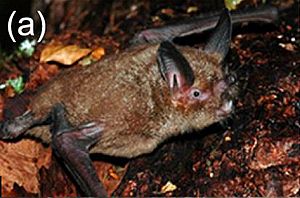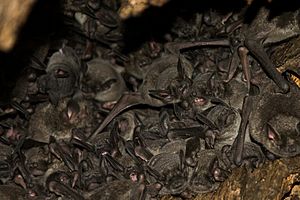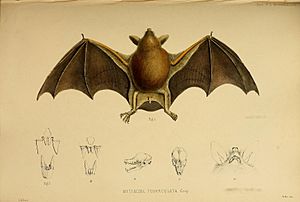New Zealand lesser short-tailed bat facts for kids
Quick facts for kids Lesser short-tailed bat |
|
|---|---|
 |
|
| Conservation status | |
| Scientific classification | |
| Genus: |
Mystacina
|
| Species: |
tuberculata
|
| Subspecies | |
|
M. t. tuberculata |
|
 |
|
| Key:
Range of M. t. aupourica. Range of M. t. rhyacobia. Range of M. t. tuberculata. |
|
The lesser short-tailed bat (Mystacina tuberculata), also known as pekapeka-tou-poto in Māori, is a special type of bat found only in New Zealand. It's the only living species in its family, Mystacinidae. These bats are unique because they spend a lot of time on the forest floor, more than almost any other bat species. Sadly, their numbers are going down because forests are being cut down and new animals that hunt them have been brought into New Zealand.
Contents
Description
New Zealand lesser short-tailed bats are quite small. Their body is about 6 to 7 cm long, and their wings can spread out to 28 to 30 cm. An adult bat usually weighs between 10 and 22 grams before it eats. After a night of hunting for food, its weight can go up by 30%!
There are only two types of bats living in New Zealand. You can easily tell the short-tailed bat apart from the New Zealand long-tailed bat (Chalinolobus tuberculatus). Short-tailed bats have bigger, pointy ears and noticeable nostrils. Their tails are also different. The short-tailed bat's tail is only about 12 mm long and sticks out past the edge of the wing membrane (called the uropatagium). The long-tailed bat's tail is completely hidden inside its wing membrane.
This bat has a long, cone-shaped nose with many whiskers. Its tongue is long and thin, about 12 mm, and has tiny hair-like parts at the tip. These hairs help the bat drink nectar from flowers. Another cool thing about these bats is that they have small claws, like tiny hooks, at the base of their main claws on their toes and wings. These help them crawl and climb. Their fur is very thick and can be dark brown or grey, a bit lighter on their belly.
Where They Live and Their Home
Short-tailed bats mostly live on the North Island of New Zealand. They make their homes in forests, from sea level up to about 1100 meters high. On the North Island, scientists have found at least nine different groups of these bats, mostly in the middle parts of the island. A few groups are also found on the South Island, like in Fiordland. Smaller groups live on Codfish Island and Little Barrier Island.
In the late 1990s, a group of about 300 short-tailed bats was found in the Waiohine Valley of the Tararua Forest Park. This is the only known group of short-tailed bats in the southern North Island. They might be related to other bat groups from the volcanic plateau and the southern areas. This group became separated from others over 90,000 years ago because of an ice age and volcanoes. Some baby bats from this special group have been moved to Kapiti Island. This was done to create a safe group of bats in a place without predators, just in case something happens to the main group.
Types of Short-tailed Bats
Scientists have named three main types (subspecies) of lesser short-tailed bats based on their physical features:
- M. t. tuberculata (southern short-tailed bat): Found on Codfish Island, in northwest Nelson, and Fiordland.
- M. t. auporica (Kauri Forest short-tailed bat): Found in Northland and on Little Barrier Island.
- M. t. rhyacobia (Volcanic Plateau short-tailed bat): Found in Northland, central North Island, and Taranaki.
Even though there are these three types, genetic studies show that there are actually six different family lines of these bats. These lines can mix and have babies together, which fits with the idea of the three subspecies. Another type, M. t. robusta, was once thought to be a subspecies, but it was later found to be a completely different species, the New Zealand greater short-tailed bat. Sadly, this larger bat is now believed to be extinct.
Diet
Short-tailed bats eat many different things, depending on what food is available. They are known as "omnivores" because they eat both plants and animals. They look for food in thick forests and deep piles of leaves on the ground. They can fly long distances from where they sleep to where they find food each night.
Their wings are shaped in a way that allows them to fly slowly and turn easily. This is perfect for flying close to the ground and traveling long distances. They eat insects like beetles, flies, and moths. They also enjoy flowers, fruit, nectar, and pollen.
These bats might be very important for helping to pollinate the wood rose (Dactylanthus taylorii). This is a special plant that grows on the roots of trees on the forest floor and is in danger of disappearing.
Behaviour

Short-tailed bats are active at night (nocturnal). During the day, they sleep in hollow trees. Many bats sleep alone in small holes in the wood. However, it's also common to find groups of over a hundred bats sleeping together. They usually use natural holes, but they can also chew out their own tunnels and rooms in the wood using their sharp front teeth. These tunnels can be several meters long. They usually stay in one sleeping spot for only a few weeks before moving to a new one. But they might come back to the same spots again and again over many years.
The bats leave their sleeping spots about 20 to 150 minutes after the sun sets and look for food for most of the night. They spend only about 30% of their hunting time catching insects in the air, usually flying less than 2 meters above the ground. Another 40% of their time is spent eating from plants. The remaining 30% is spent hunting on the forest floor. This is more time on the ground than any other bat species!
To help them hunt on the ground, short-tailed bats can fold their wings inside a special protective skin. Their wings are also very flexible. Strong back legs and extra claws on their feet help them move around easily on the ground.
They find their prey using smell, by listening carefully, and by echolocation. Echolocation means they send out high-pitched sounds and listen for the echoes to figure out where things are. Their main calls are loud and have a wide range of sounds. They also make shorter, changing calls. When the weather is cold, these bats can go into a deep sleep called torpor. They might stay in their roosts for up to 10 days without eating. If they are sleeping alone, they might go into torpor every day. But they can also stay active even when it's freezing cold if they need to.
Reproduction and Life Cycle
Short-tailed bats have a special way of finding partners. Males gather in certain areas (called a "lek") during the breeding season. Each male takes over a special mating roost and makes repeated high-pitched calls to attract females. The males also mark the entrance to their roosts with a musky-smelling oil from glands on their throats. This smell might also help attract females. Mating usually happens between February and May.
After mating, the baby bat (embryo) doesn't start growing right away. It waits through the winter in a state called delayed implantation. Then, a single baby bat is born in the summer. Newborn bats don't have fur, but they are otherwise well-developed and weigh only about 5 grams. Their permanent teeth grow in at three weeks old. By four weeks, they have full fur and can fly. They leave their mother's roost at six weeks and grow quickly, reaching full size within three months.
Conservation
The different types of lesser short-tailed bats are listed as "Nationally Vulnerable" or "At Risk" by the New Zealand Department of Conservation. This means their populations are decreasing and they need protection. This bat species is also the only home for a special insect called the New Zealand bat fly. These two creatures live together in a close relationship that helps both of them.
Images for kids
See also
 In Spanish: Mystacina tuberculata para niños
In Spanish: Mystacina tuberculata para niños




